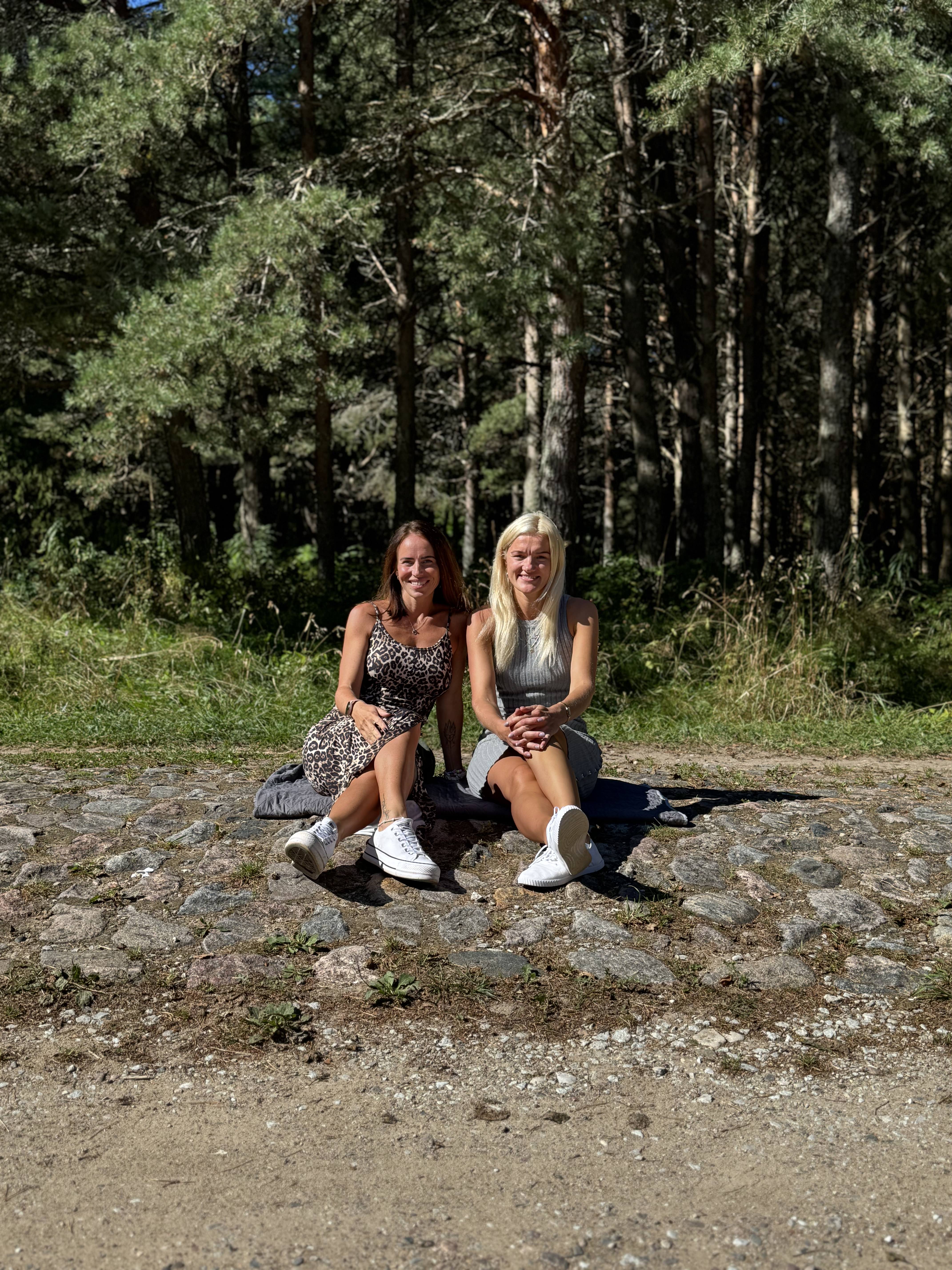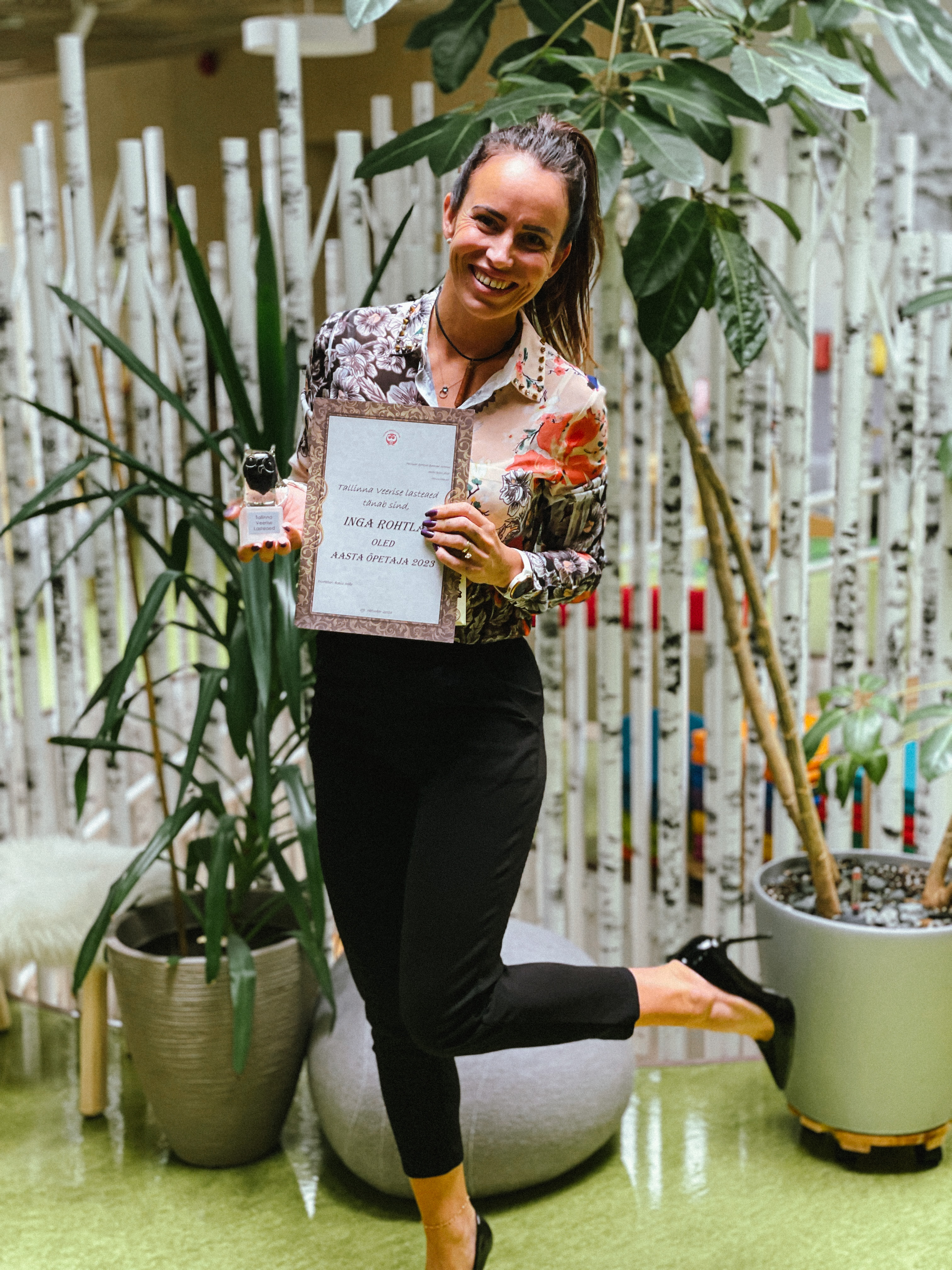We met Inga Rohtla at her home beach in Suurupi, a woman whose passion is movement and whose energy is as vibrant as the sea waves beside us. Pleasant hours on the sand and in the sea breeze provided the perfect setting to talk about movement, children, and being a teacher. Inga’s story is a true example of how stepping in to help at her own kindergarten turned into a new career path that has brought her joy, recognition, and new challenges.
How did your journey as a movement teacher begin?
My journey as a movement teacher began at the time when my children attended Tallinn Veerise Kindergarten, where getting a place was not at all easy. After some time, one of the teachers from my older son’s group left the job and the whole group was left in the care of a single teacher. She was a strong character and always managed, but it was clear from the outside that the workload was heavy and it was hard for her.
I still don’t know exactly what went through my head at that moment or why I offered it. I just said that if the director agreed, I could come and help until they found a new person. Looking back today, I think it is simply my nature. I am bold and I offer help when I see someone needs it. But working with children had never been part of my plan.
I cannot say that I do not like children – I like my own very much and raising them suits me well. But I have never been the kind of person who knows how to cuddle other people’s children or overly pamper them. Rather, I have kept a distance.
Anyway, I offered myself and the director agreed. So I spent a month as an assistant next to a teacher. When I went home and told my husband that I was now in kindergarten helping a teacher, he looked at me with this face: “You and working in kindergarten? But you don’t even like children!” And in a way, he was right.
That time coincided for me with both the competition period and my personal trainer studies. The head of studies at that time suggested in a meeting: “Inga, start giving us trainings as well!” A new teacher had already been found for the group, but I was asked to come to the kindergarten to conduct trainings.
At that time, I was a student of Marek Kalmus. I told him that they wanted me to give classes, but I was still studying to be a trainer and didn’t know how I would manage. But he immediately said: “Let’s do it! I’ll come with you the first time and support you.” And so I began giving classes. At first, it was mainly teachers who attended, sometimes also some parents.
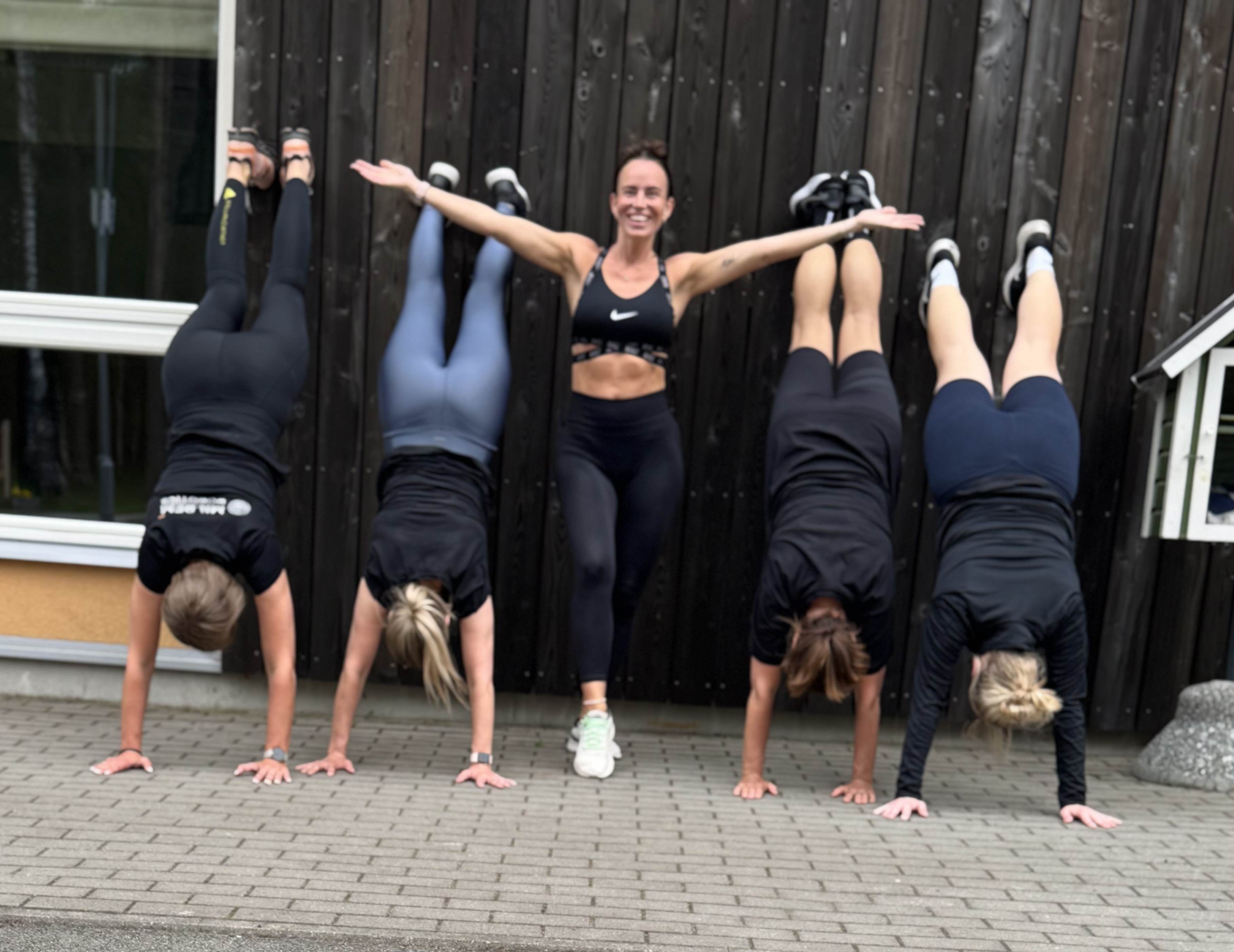
I no longer continued as a teacher’s assistant, but the classes remained. At one point, the director came to me and asked: “Would you like to become our movement teacher?” I did not have the proper education, only my trainer studies, but I thought, why not. I enjoy both doing and leading training, even though I couldn’t imagine working with children.
At first, it seemed that the existing movement teacher would not leave after all, then again that she would. In the end, she did leave, and I got the chance. That was the moment I told my husband: “Now I am really going to work at the kindergarten, as a movement teacher, with children.”
In 2019, I officially became a movement teacher. And it all started simply because I was a parent who offered to help.
What inspires and motivates you the most in this work?
I think what motivates me the most is knowing that I can share with children the basic truths, the foundations where everything begins. I used to be an athlete myself and I know what it gave me. It taught me discipline, it showed me how important movement is for the body. At that time, I knew nothing about nutrition. That is exactly why it is so important for me that I can pass on knowledge that matters to children from an early age. I don’t know what happens at home, whether families move together with their children or whether a healthy lifestyle is talked about at all.
For me, in the beginning, it was a completely foreign land. The curriculum, the activities, and what a child should know—I didn’t know any of that. I learned along the way, by experimenting and using logic. I didn’t attend school for it, I only took a few individual courses, but mostly I learned on my own. Looking back, it seems that it worked. Children liked what I offered them, and that gave me confidence.
In addition to movement, at one point, while studying to become a trainer and learning about nutrition, I also started sharing that knowledge with children and teachers. At least twice a year, we did nutrition workshops, talked about the food pyramid and healthy choices. It was clear that as the children moved from one group to another, the next year they already remembered the earlier lessons and were able to join the conversation. They always remembered the top parts of the pyramid best, which they could name right away.
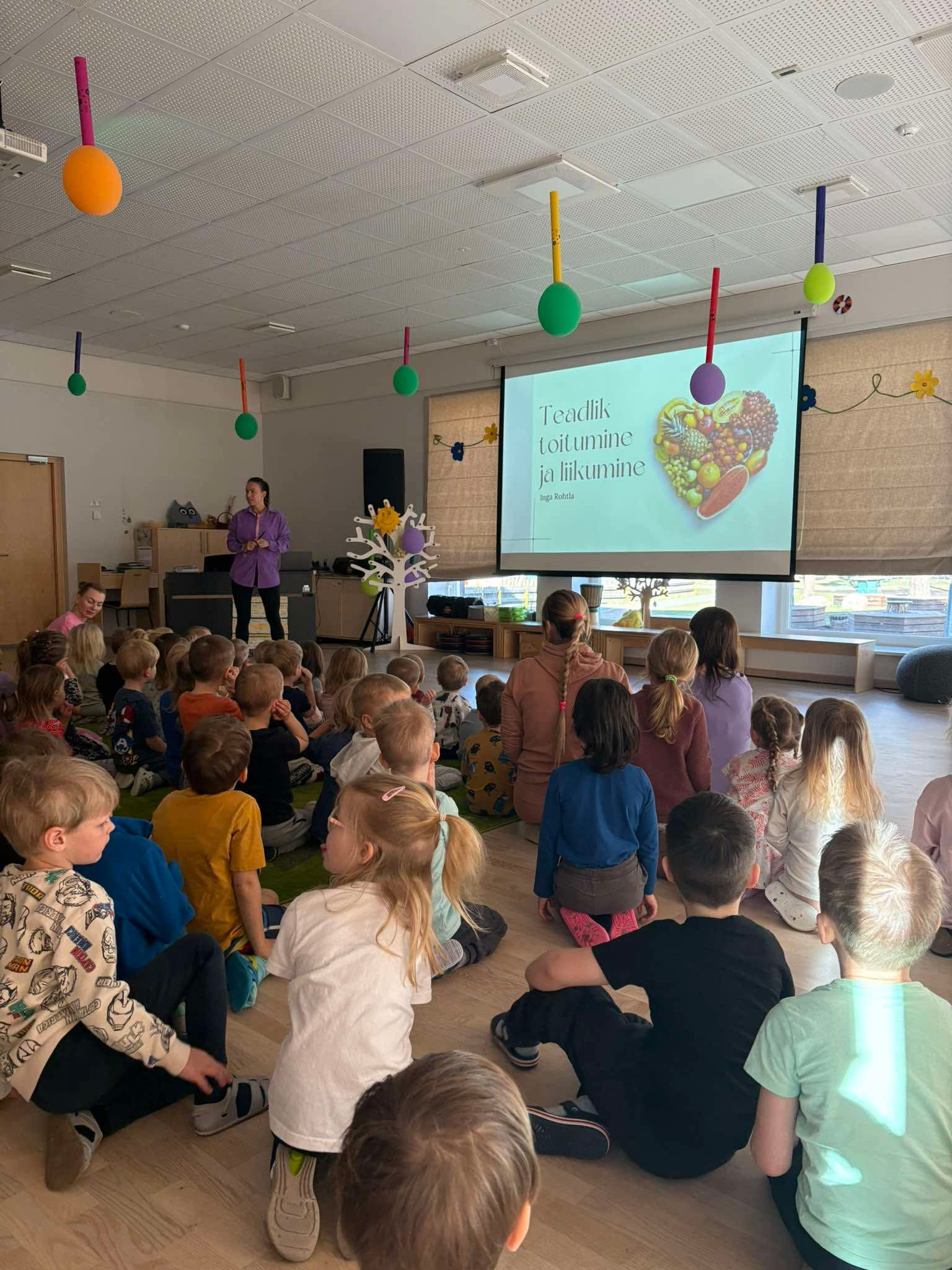
But I emphasized that at the very bottom of the pyramid is actually movement. Not just nutrition, but movement together with nutrition is the most important. And that is exactly what motivates me—that I can share my knowledge with such little people, who are still untouched, and whose habits can be shaped from the right place from the very beginning.
If I peeked into your movement class, what would I see and hear?
When I started as a movement teacher, one of my clear wishes was that in my class there would be only children, not group teachers. I wanted the children to know that they listen to me and turn to me, not to someone else. I did tell the teachers that they could come and watch how the lessons take place, but for me it was important that the movement class was the children’s time. I also gave teachers feedback and filled in tables so it was clear who could manage what and where more practice was needed.
In my classes there was always order, and quite a strong order. I can’t say exactly where it came from, since I hadn’t really learned it anywhere, but that’s how it developed. The lesson began with a lineup, where the children stood straight and listened to what we were going to do. Sometimes I also asked them what they would like to do, so that the class would have more child-centeredness. They obeyed quickly, and I believe they respected me very much.
Although I was demanding, there was never a situation where the children didn’t want to come to my class. On the contrary, they always looked forward to it with joy. They quickly understood that when they entered the hall, they stood in line and did not run around. It was like a little military order, but it worked. Often, if someone from outside the hall came in, it seemed to them as if there was no one there at all, because everything was so calm and focused.
Of course, during playtime it was allowed to run, laugh, and make noise, but I had to keep in mind that I shared the hall with the music teacher. Because of that, I couldn’t allow the children to make too much noise, even though sometimes they really needed it. It is natural that children want to run and shout or laugh at the same time. Yet I managed to keep a balance: order and demands were present, but at the same time there was a lot of joy in the class, and the children were not intimidated. They felt good and always wanted to come back.
What is the children’s absolute favorite activity in your classes, and why does it win their hearts?
I would actually like to know myself what the children liked most about my classes. I’ve asked them, but most of the time their answer ends up being that they liked the game we played last. But one thing is certain – when they came into the hall, their very first question was always: “Are we going to play tag today?”
There are endless variations you can create from the tag game. Our favorite was plank tag. In this version, the tagger had to catch someone, the caught child went into a plank, and another child could rescue them by crawling underneath. This meant that all the muscles of the body worked at once – a game and a workout together.
Still, I don’t think the children came to my class only because of tag. They knew that in our classes there was order and clarity, that it wasn’t a place where everyone just did what they wanted. Chaos quickly becomes exhausting, but order and routine give a sense of security. I also saw this in the feedback from parents. There were times when parents came to tell me or even sent videos from home, showing their child organizing their own “Inga movement class.”
In one particular video, one child told another: “Go nicely behind the line now,” and you could see the same order that we had in class. It was never bossy or forced, but the children themselves wanted it that way, and it worked. Just recently, a parent sent me a picture of her child sitting cross-legged at home, breathing calmly. She said: “Inga taught this.” It was indeed our custom that at the end of the lesson we sat cross-legged, breathed, and calmed down. I counted calmly to ten, and most of the children took it seriously, although there were always some who peeked with one eye or giggled. But that too was part of the learning.
So the lesson developed into a clear rhythm – we played, we did exciting things, we learned, and finally we calmed down. Sometimes, when someone lay down, I stroked their head and told them they had been very good and calm. Praise was always an important part of the lesson.
What is the one thing you would like every child to take away from your movement classes?
The first thing that came to my mind was that you have to try. It doesn’t matter what it is – whether it’s nutrition or movement – you have to try. You can’t know if you’ll like it or if it suits you before you’ve tested it. And even if you fail at first, you have to try again, because we all fail. For example, I couldn’t do a cartwheel, but now I’m learning and getting better step by step.
It’s important to give yourself a chance. I think this could even be one of life’s principles – whatever you want to do, don’t leave it untried just because you think you won’t succeed. If you don’t try, you’ll never know.
What are your 2–3 simple games or exercises that any teacher can do with their group without preparation?
It is difficult to point out a specific activity, but one simple example is a game where children take off their shoes in the group room and line them up by themselves. The shoes can be placed exactly as the children want – sometimes crossed, sometimes straight, sometimes completely messy, or even with just one shoe. And that’s where the game begins. Children move along the path they’ve created and must place their feet in the same positions as the shoes. If the sneaker is turned sideways, they must also step sideways. If one shoe is facing the other way, they have to jump there accordingly. It’s so simple, yet so exciting – they create the path themselves and immediately complete it. And sometimes they make it so tricky for themselves that they’re surprised at how their feet can even manage in such positions.
When I have substituted for a group teacher in the group room, we have often played exactly these kinds of games:
Snake game – children stand one behind the other with their legs apart, the one at the back crawls through from the front and tells the next one, now it’s your turn.
Crawling games – where they must test skill and patience, moving on the floor on their stomachs or on all fours.
Passing object games – a ball or even that same shoe moves from child to child, creating excitement and practicing cooperation.
Pencil grabbing game – the child must quickly grab the pencil from someone’s hand. Simple, but develops both coordination and reaction.
Relay race in the group room – for children this is especially exciting, since normally running there isn’t allowed.
Crawling tag – when running isn’t possible, tag can be played while crawling. Just saying the word “tag” already makes the children excited.
But the dearest to me is still the shoe game. I always explain beforehand what needs to be done, and then I watch how children sometimes place their shoes completely the other way around. Then you really have to think about how to jump over without twisting your ankle. Children make the game harder themselves and have to use their brains in the process.
With the younger ones, like 1.5-year-olds, we don’t play such complicated games. Simpler activities suit them. For example, hot ball, where the ball has to be quickly passed on to the next one. Their reaction is slower and even though it seems to them that the ball is moving at lightning speed, in reality it moves very slowly. But the excitement on their faces is priceless.
Actually, it’s often the youngest children who are the most diligent in movement classes. Preschoolers already want to run and rush immediately, but 1.5-year-olds listen, observe, and join in thoughtfully. They are super sweet and very, very diligent.
How to lure a child away from the screen at home without it turning into a battle?
This is our everyday topic. Often a child is told: “Go outside, the weather is nice.” But what really works is not saying “go,” but saying “let’s go.” Doing things together is the most important.
First of all, the question is how much time parents actually spend with their children. Being together does not simply mean being in the same room. Shared time means that the parent is actually doing something with the child. If you say to the child: “Let’s go for a walk,” there’s a good chance the child won’t say no, unless they are already under the influence of computer games. The same goes for when you say: “Let’s play with Legos” or “Let’s go cycling.” It is the doing together that is the most fun.
In our family, it is the father who truly plays with the children. For example, we recently talked about the younger one starting wrestling. The father started wrestling with him at home, and that got the child moving – he no longer thought about cartoons. In fact, parents could do more of these kinds of things together with their children.
For several years now, I’ve also had my own project in April, the month of the heart. I’ve organized a step challenge for about four years. At first it was only a kindergarten event, then it expanded to the community, and eventually to the entire Haabersti district. It wasn’t just about walking alone, but about creating a pattern. Parents showed that they were moving, and children saw this from the sidelines or joined in.
Participants were enthusiastic. Some even took vacation time to be able to walk more. One man went on a pilgrimage in Spain and walked the entire April – no one could keep up with him. Over the years, I changed the system so that there were no longer fixed first places. Some walked a lot, but for others it was already a big step just to get off the couch and go for a walk. Stepping out of the comfort zone was the real victory.
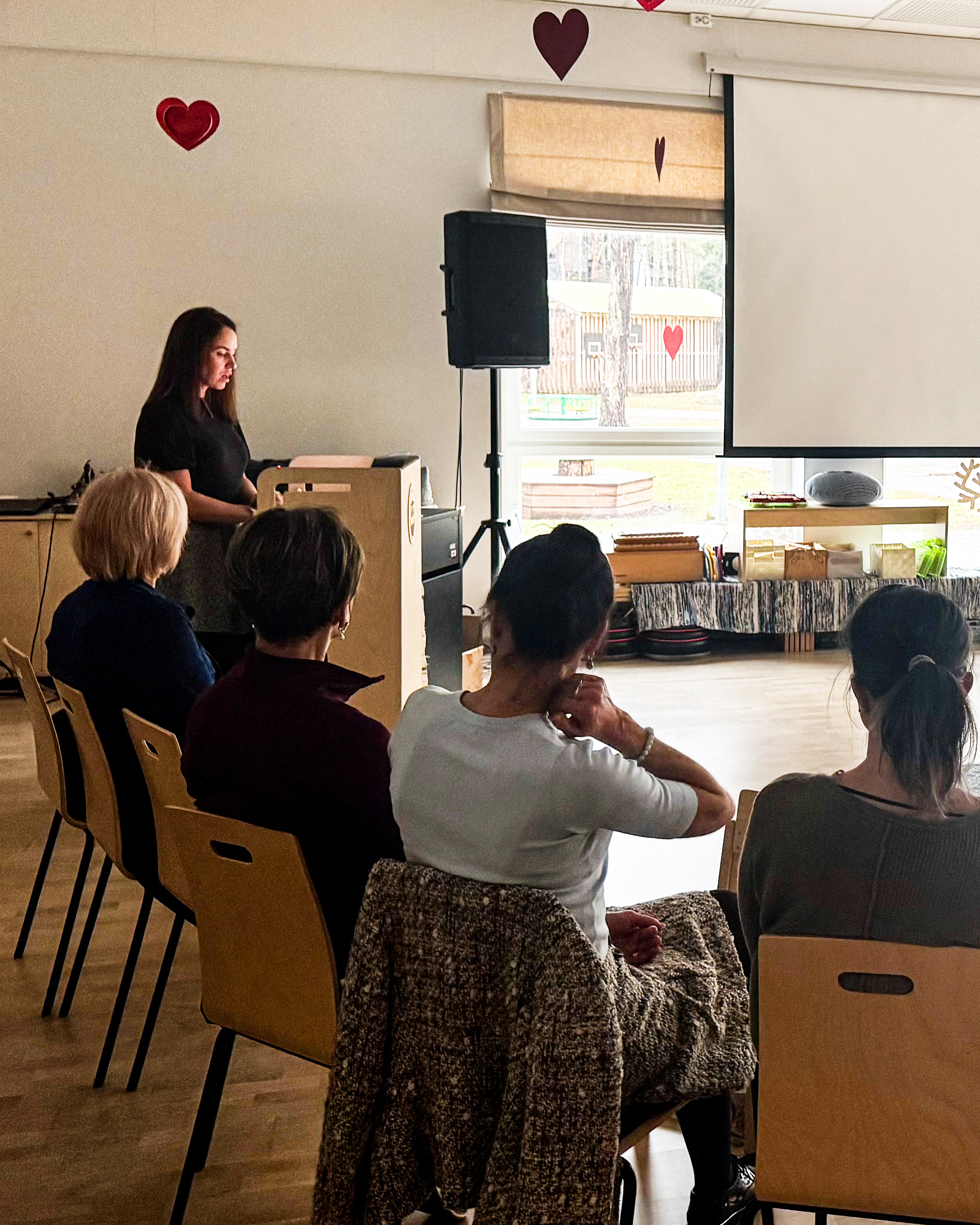
At first, the prizes were, for example, a Veerise kindergarten mug. Later, I received funding from the city of Tallinn and spa passes from sponsors, Vitamin Well drinks, Nicks products. In addition to motivation, people also had something exciting to look forward to. But the most important thing remained the same: the movement itself, for yourself and your heart.
Parents participated actively, but the goal was for children to see this pattern. You could take your child along and do it together – even just one kilometer. If the child rode a bike and the parent walked beside them, that was perfectly enough. The important thing was not how much or how fast you covered, but that you did it together.
Whether the step challenge will take place again next year, I don’t yet know. Organizing such an event is a lot of work – you need to find supporters, create an account, track kilometers, and arrange prize draws. But I enjoyed it, and it was very nice to see how parents were already asking beforehand: “Will it happen again this year?”
The core of the whole activity remains simple: “If you want to lure a child away from the screen, then join in yourself. If you lead by example and say let’s go, the child will happily follow.”
You have also held movement classes for kindergarten staff – how has this affected your team spirit?
Inga recalls that she started offering training sessions for staff in 2019. “At first, mainly teachers came. I kept emphasizing that this is such a perfect opportunity – after a workday it may feel hard, but after a workout you always feel good.”
Over time, however, the proportion of teachers decreased. “Today there are no teachers left in our group. Instead, it is mostly parents and some people from the community. Some start with me, but when I see that they are ready for the gym, I recommend they move on. Sometimes someone comes back to me from the gym – because in my training you don’t get only physical exercise, but also mental. You can share, talk, laugh together. It is a completely different experience.
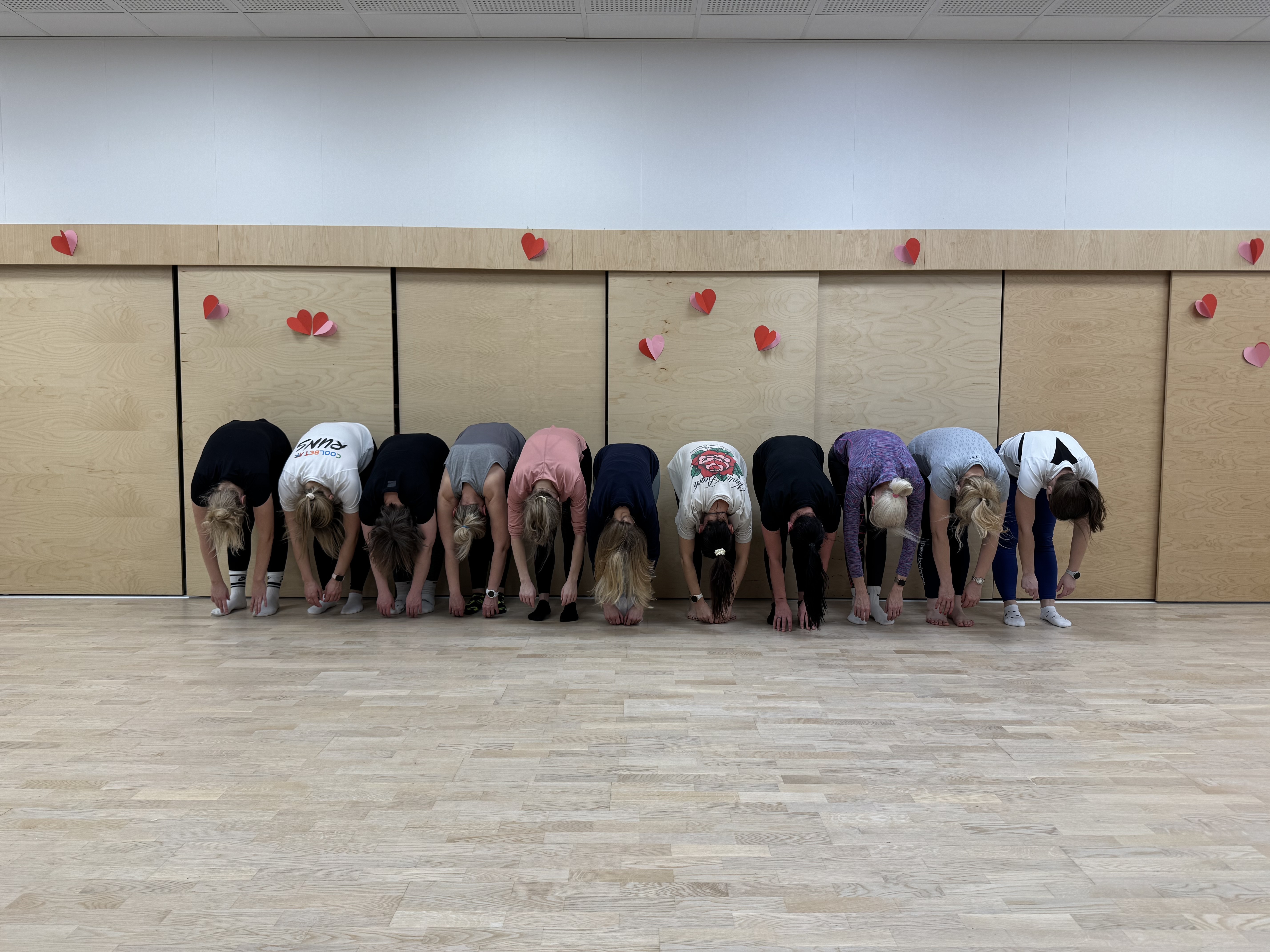
About the team she says directly: “At Veerise we otherwise had a very close-knit staff – we went on outings together, to the theatre, even on summer trips. The workouts could have been just as much of a unifying force, but unfortunately not everyone found that motivation within themselves. This kind of thing has to come from inside a person, not only from the team.”
At the same time, Inga believes that any shared activity, whether it is sports, hiking, or a cultural event, helps strengthen the team. “Training could fit this purpose very well. But I am grateful that at work we also had many other joint activities that connected us.”
How does ELIIS support your daily work as a physical education teacher?
ELIIS provides a good framework to write down thoughts and plans. At the same time, movement lessons are never exactly the way I write them at the beginning of the month. For example, I might think that today we will do jumps or coordination exercises, but the lesson begins and the children have a completely different vibe. Then I change the plan according to the situation – and sometimes the lesson goes in a completely different direction.
When the children are tired, Inga does not push them to exert themselves. “Then we talk instead about athletes or nutrition. Or I give a calmer class where the children, just lying down, sense their bodies: move their fingers, breathe deeply. They calm down. For me, it is important to observe what the children need at that moment.”
This is where ELIIS helps. “If the group teacher has made an entry about a child, then I can see that the child wasn’t sad only in my class, but already in the previous activity. That signals to me that something may be happening at home or that the child is dealing with some worry. Knowing this helps me respond better.”
She also reads group project plans from ELIIS. “If they are currently studying birds, then I can do swallows with the children in my movement class. Or if they have an outdoor learning week, then I plan my lessons outdoors as well. Such integration makes the learning more complete for children.”
Inga also emphasizes how important the parent’s perspective is. “When, through ELIIS, parents get to see what we are actually doing in class, then they realize that physical education is not just running around. There is structure, habits, knowledge, and also the management of emotions.”
If you could give one piece of movement advice to children and adults, what would it be?
“It is still the same – doing things together,” Inga emphasizes. “When a bond is created between a child and a parent through shared movement, it can only bring positive emotions. The body is made to move, and no one can honestly say that after moderate exercise they feel bad. On the contrary, it gives you more energy.”
It often seems that movement takes away strength. “In reality, it gives back much more. The only bad workout is the one that didn’t happen,” she says.
Inga recommends creating small daily routines: “Even just one kilometer every day – it doesn’t take long, but the habit forms. Make it a little challenge, for example put up a chart on the wall and mark each day with a tick: did we go walking today. It’s the same as brushing your teeth – you don’t skip that.”
And it doesn’t have to be just walking. “It can also be cycling, going to the skatepark, or even playing ball indoors. The main thing is that the child sees: movement is a natural part of life and it is done together.”
In 2023 you were chosen as Teacher of the Year. What did this recognition mean to you?
It was a great recognition for me. It is nice to see that my efforts have been noticed and valued. When I do something, I always give a lot of myself. Often it is the group teachers who receive the Teacher of the Year title, and sometimes the work done by movement or music teachers or even support specialists goes unnoticed.
This time I was in the selection together with a very strong teacher. I was absolutely certain that I had no chance, because she really is an excellent teacher. But it turned out that I was chosen as Teacher of the Year instead, and I immediately felt how it gave me new strength.
At the same time, this moment coincided with a very difficult period for me. In the exact same month that I received this title, my own coach, Marek Kalmus, passed away. It was a great loss for me and brought me down. Maybe it was not immediately visible, because I still wanted to work, but in reality I was in a bad state myself. Still, I never had the feeling that now I had the title and no longer needed to make an effort. On the contrary, it just took me some time to recover and to start thinking about work again.
The Teacher of the Year title was truly wonderful. Recognition is always good to receive, especially when you know that you have truly worked hard and achieved a lot.
From September 1 you will start working as a physical education teacher at Tabasalu School. With what expectations and thoughts do you approach this new challenge?
It is very difficult to let go of the little ones, because they are the ones to whom you can shape knowledge and habits from zero. At school the situation is different – there are children who already have their own habits and experiences, and reshaping them can be much more difficult. But at the same time, I like challenges and I approach this new stage with excitement and hope that I will manage there as well.
In kindergarten I think I did very well – people often said: how do you manage that a whole kindergarten full of children is only with you, and yet there is order. I organized all kinds of Halloween parties for them, where only children came, not teachers, and it all worked. I have such a voice and presence that when I say something once, the children understand what to do, and often just a glance is enough.
Of course, not everything is always rosy and there are exceptions, but I believe that when a child behaves badly, you must always look into yourself as well. Often it reflects either the child’s inner emotion or also the teacher’s own state. If you are calm and balanced, then the children are calm as well. This knowledge I will take with me to Tabasalu.
From September 1 she begins a new chapter at Tabasalu School, leaving behind the dear kindergarten children but taking with her valuable experience and the knowledge that even with a hall full of children you can manage if your heart is full of passion and your eyes shine. I believe that the Tabasalu school family will gain a physical education teacher who can instill in children not only the joy of movement but also the courage to try boldly in life. Inga’s message is simple, yet powerful: if you are calm and balanced, this is passed on to the children.
